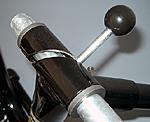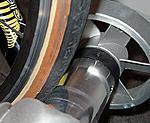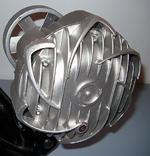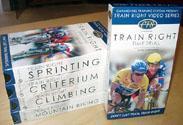
Recently on Cyclingnews.com |
Reviews
Smooth as silk
CycleOps Fluid2 home trainer
By Anthony Tan

|
Until recently, I've had relatively few options when it comes to training on the bike: stay in bed (if it's six in the morning) or go to the pub (if it's six in the evening).
I do have a good excuse, however. A decade of playing tennis on predominantly hardcourt surfaces, mixed in with cross country running as part of my cross-training programme - then another eight years of bike racing on top of that finally took its toll on me, or my right knee, to be precise. The extensive arthroscopy that followed prevented me from riding my bike at all for almost two years... a very strange feeling indeed.
After a prolonged hiatus, I certainly wasn't ready to tackle the streets of Sydney straight away. It wasn't an issue of strength - I had slowly been rehabilitating my degenerated leg muscles during that time - but more to do with confidence on the road one takes for granted. The rollers weren't an option either - there was still a huge muscle imbalance between my left and right legs, so the only scenario left was to buy a fixed-wheel home trainer. I decided to bite the bullet and get one of the best my money could buy, the CycleOps Fluid2.
First looks

|
I was attracted to the Fluid2 for three reasons. First, I live in an apartment, so noise disturbance, or more precisely lack of it, is vital. After a short test ride on a few models at the LBS (local bike shop), the Fluid² was, by some margin, the mousey-est of the lot.
Accounting for my current physical condition, I also figured the relationship with my home trainer was going to be a close one for the next six to twelve months, so I needed a machine that could go the distance. The Fluid2's fully-sealed resistance unit, the quality of components and the simplicity of set-up provides every indication that this machine will go the full nine yards and more.
Last, and common to all my big-ticket purchases, the CycleOps Fluid2 simply looks mighty fine. While the sight of me half-naked in my cycling shorts, grunting on the balcony in full view of the residents living on the opposite side of the road, is enough to turn a hunger-starved individual off eating forever, at least my equipment looks good.
Set-up
A cinch. Take it out of the box, extend the legs (which are independently adjustable to provide a level footing on uneven surfaces), attach the resistance unit to the frame with the carriage bolt, then insert a L-bolt into the bracket at the back of the resistance unit and turn clockwise - a few turns will bring your rear tyre in contact with the roller.

|
The trickiest operation is actually what appears to be the most simple: installing the quick release mechanism into the frame. Unless you're used to hammering hard-to-fit objects in with the palm of your hand, make sure you use a rubber hammer when attempting to insert the bolt action tube through the frame. As you lift your bike up and place the left side of the wheel's skewer into the fixed cone of the trainer frame, it becomes a matter of trial and error screwing in the quick release handle into the bolt action tube. Depending on your bike and dishing of the rear wheel, there's three holes on the tube to allow your wheel to be centred on the roller of the resistance unit; the instructions say this isn't necessary, but my feeling is that if you can, you might as well.
The final step involves making sure your rear tyre has adequate contact with the roller; if the tyre slides, simply turn the knob clockwise at the back of the resistance unit. With the initial set-up complete, it's a very basic two-step operation for subsequent training sessions - wiggle the left side of your skewer into the cone and pull down the quick release handle into the locked position. Now you're ready to suffer!
Spinning 101

|
With the plethora of online and off-line training programs, manuals and personnel out there, some telling you to train this way, others saying you should do that, it all becomes very confusing.
Which is why your first point of reference should be (big plug coming... ) the CYCLINGNEWS FORM & FITNESS PAGE! Or (another big plug coming...) CycleOps' CTS TRAINING VIDEOS!: "Train right video series."
Seriously though, just doing a shortened version of whatever training session you're used to doing will suffice and help you retain or, over an extended period of time, improve your strength and fitness on the bike. Altering the intensity/resistance, mixing up the duration of your intervals and sticking to a regular programme will result in more rapid or further improvements in strength, endurance, or a combination of both, which is what aerobic fitness is based upon.

|
My first workouts on the Fluid² were all low-intensity. After a prolonged lay-off, my only goal was to reacquaint my legs with a fluid as possible pedalling motion that involved spinning a relatively easy gear (mostly 42x17/19) for half an hour to 45 minutes 2-3 days per week.
Unlike many other trainers with manually-adjustable resistance, the resistance level on the Fluid² uses what's known as 'Power Band' technology, where the load varies depending on your cadence and wheel speed. As a previous user of rollers (which offer no additional resistance at all), the intensity was more than adequate for my purposes - CycleOps claim the power output can vary from less than 20 watts to over 725 watts (at 36.21 km/h or 22.5 mph). When you do change down a gear, the extra resistance does take a few seconds to kick in, but you'll feel it, believe me.
However, I can see that for a number of pros - and a few masochists out there - the level of resistance may not be sufficient to really kill yourself - which, apparently, is the object of the exercise according to my friend Nathan 'Chookman' Russell, who rides for the Colavita-Bolla professional cycling team.
The verdict
For those that don't need to replicate going up Fillmore Street eight times (which is what Chookman had to do at the San Fran GP), the CycleOps Fluid2 is great. It's easy to set-up, quiet (even quieter if you buy a rubber mat to place underneath you and your trainer; easy to wipe off sweat, too), does an excellent job of sensing the intensity of your load, and requires no maintenance other than wiping your sweat away to stop corrosion. And I guess the greatest testament is that six months later, I only use it when it's raining or can't be bothered fighting Volvo drivers. As Willie Nelson would say, I'm on the road again!
Photos
Images by Cyclingnews/Anthony Tan
- The CycleOps Fluid2 - the Mercedes Benz of fixed-wheel home trainers?
- The fully-sealed resistance unit prevents sweat and debris from entering and also houses the cooling fan.
- The flywheel is surprisingly quiet, although like all fixed-wheel trainers, the higher the speed/resistance, the greater the noise.
- Once the quick release mechanism is installed, locking your rear wheel into the trainer is a breeze.
- The engine room. Apart from your own set of lungs, of course.
- For those with non-standard skewers, CycleOps include a standard shaped skewer for a perfect fit.
- Good contact between the tyre and the roller is essential. Also, it's a good idea to have an old set of tyres kicking around due to a fast rate of wear.
- The Cyclerobx Training Video - Worth seeing just for the baby faces and big hair.
Images by Cyclingnews/Kristy Scrymgeour
- The Fluid2 in the Postal team colours
- The Fluid 2 base in blue
- The quick release
- Bike locked into position with the quick release
- The Fluid 2 comes with five CTS videos
Recommended retail price: US$299.99 / A$479.99
Pro: Well built, comparatively quiet, progressive rather than manual
resistance, excellent for rehabilitation
Con: Quite heavy, a max output of 725 watts may not be quite enough
for the Super Marios out there
More information: CycleOps
web site
Cyclingnews Rating: ![]()
* The model reviewed is a 2003 model CycleOps Fluid2; we have also been told by the manufacturers that the Cyclerobx video has already been superceded with a training video produced by Chris Carmichael, which will be reviewed shortly.
What do you think of the CycleOps Fluid2? Let us know


